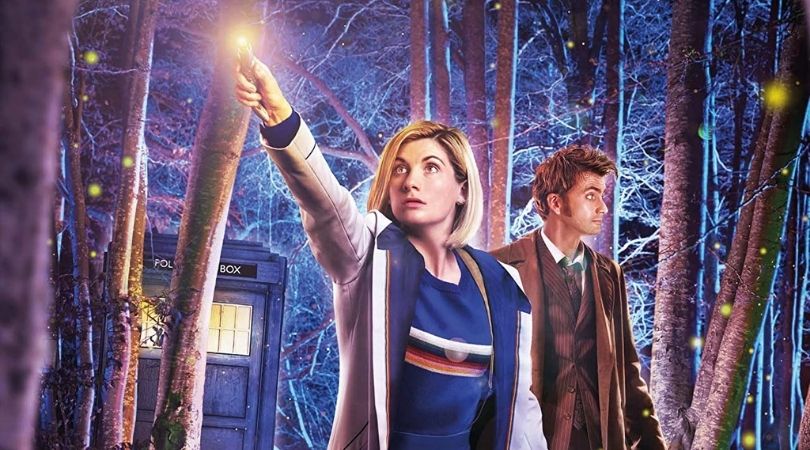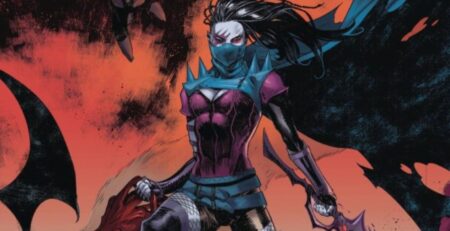
Doctor Who Volume 1 is a trade paperback published by Titan Comics, based on the BBC sci-fi series. The writer is Jody Houser, and the artist is Roberta Ingranata. Colours by Enrica Erin Angiolini. Flatters by Shari Chankhamma and letters by Richard Starkings and Sarah Hedrick.
In their previous adventure, The Tenth and Thirteenth Doctor teamed up. But after separating, the Doctor and her companions discovered that the Earth is now changed immeasurably. The Sea Devils have taken over the world and have kept the human population as slaves. Leading the human resistance is Rose Tyler, fighting a losing battle. Both versions of the Time Lord arrive on this changed planet, realizing that a familiar historical figure is part of the reason for the alterations. With two Doctors, three companions, a companion that doesn’t know she was once one, and a surprisingly friendly alien queen, the group must try and save history yet again.
The plot itself is well-paced and fun, constantly moving forwards (and backward) in time. While the paradox’s reveal appeared at the end of the last volume involving these two regenerations, that information isn’t necessary for new readers to jump on. Most of these revelations are just as powerful in the opening pages of this comic. Likewise, this series takes strong inspirations from the TV episode “Nikola Tesla’s Night of Terror.” But the characters involved and the way Houser scripts the references means that previous knowledge isn’t required.
The fantastic part of the story is that it takes multiple elements from both Doctors’ world and tells a brand new story. It isn’t just a stream of references and callbacks, the events in this comic matter. There are some incredibly poignant moments within Doctor Who Volume 1 but also moments of intense fun. One of the endings was entirely unexpected and one of the most profound Doctor Who moments. The final page is a cliffhanger, leading into the next Thirteenth Doctor adventure.
Perhaps Houser’s biggest strength in the Doctor Who comics is just how precise she replicates the voices and personalities of the characters. The characters act and talk exactly as they do in the TV series, which makes the exploration of them on page seamless. There isn’t as much conversation between the two Doctors as there were in their last team-up, as the script focuses on their experiences with other figures in the comic. The comments between the Doctor and this completely different Rose are beautiful. The Doctor can hardly keep his emotions in check around her while Rose has become someone he barely recognizes. But even having them in the same room together will always bring a lump to any Who fan’s throat.
The other alien character that appears as a companion is a terrific addition to the comic. Their inclusion was a surprise and took the story in a whole new direction, but it adds more depth to a species that hasn’t had extensive development. Their arc is significant and is completed by the conclusion. That can be said for many of the characters used solely for the duration of this trade paperback.
However, it may have been beneficial to see more of the changed world that Rose lived in. Beyond the first chapter, the time-travelers are back in their TARDIS’ and moving into multiple timezones. More explanation and depth to the dystopia would have been largely appreciated. Even the Sea Devils lose importance quickly. And some deeper exploration of the human resistance would have been fun. There are many cast members already, but cameos from other characters left on Earth by the Doctor may have added some small moments of gratification.
The art is superb as Ingranata and Houser reunite as a creative team. The artist has a similar approach to the writer in their rendition of the characters: take existing elements and adapt. Each of the known protagonists looks amazing and is instantly recognizable. There is a variety of time periods involved, and all of them are fantastically created. The backgrounds have small, thin lines that display terrific landscapes. This version of London has been completely redesigned as the paradox altered the city’s growth entirely. And the Doctors being in the same place at one time fuses their time TARDIS together. This creates a brilliant amalgamation of the two designs.
Angiolini and Chankhamma also return in Doctor Who Volume 1, providing sublime colours. Many of the intricate details come from the shades as opposed to the line art. The design of the alien newcomer is utterly amazing, and there are beautiful flecks of light on their face. The lighting frequently changes, from dystopian futures to the TARDIS to the past.
The lettering is easy to read and dynamic. Starkings and Hedrick give custom word balloons to certain characters, but they are always legible.
Doctor Who Volume 1 is a brilliant comic that brings back old stories to tell new ones. The reader will feel heavily invested in the characters, from the ones we already know to the brand new ones. The old characters that existed feel authentic to their TV counterparts. When Rose speaks, you can almost hear the London accent. The plot is exciting, but this new world itself could have done with some more exploration. Overall, as a sequel to the Doctor’s last team-up, it is extremely effective.
Doctor Who Volume 1 is available on May 11th, wherever comics are sold.
Doctor Who Volume 1
TL;DR
Doctor Who Volume 1 is a brilliant comic that brings back old stories to tell new ones. The reader will feel heavily invested in the characters, from the ones we already know to the brand new ones. The old characters that existed feel authentic to their TV counterparts. When Rose speaks, you can almost hear the London accent. The plot is exciting, but this new world itself could have done with some more exploration. Overall, as a sequel to the Doctor’s last team-up, it is extremely effective.




